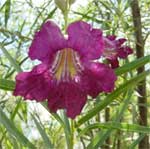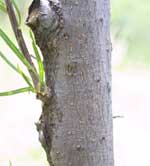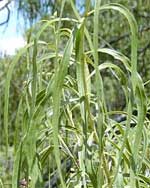
Desert Willow Tree
Scientific name: Chilopsis linearis
Description: Called a “willow” only because of the leaf resemblance. It is actually related to the catalpa. Can grow into a bush or a small tree (possibly with multiple trunks). Leaves are 6 to 12 inches long and narrow; deciduous. The airy foliage casts a light but cooling shade. Desert Willow has become one of the most popular native plants for landscaping. Designated the official tree of Albuquerque in 1964, Desert Willow is native to dry washes and arroyos below 6,000 feet. While it is very drought tolerant & loves full sun, it grows more rapidly when given extra water while young. Its northern limit is just north of Albuquerque near Algodones. Fruit: Capsule/bean 4 to 12 inches long.

Desert Willow flower
Flowers: 1 ¼ inches. Its beautiful, bell-shaped flowers, range in color from white to pink or lavender. It blooms from May until frost.
Bark: Dark brown, ridged and scaly.
Height: 10 to 25 feet
Diameter: 6 inches
Elevation: Up to 6500′
Hardiness Zones: 6 to 10 (New Mexico to Mexico)

Desert Willow Bark
Soils: Tolerant of drought and alkaline soils.
Habitat: Moist soils of stream banks & drainages in plains & foothills, desert & desert grasslands, often forming thickets. Found in Texas, New Mexico, Arizona, S. California, SW Utah.
Wildlife: Hummingbirds love its flowers.
Use: Important in erosion control. Stiff durable wood suitable for fenceposts.
General Care: Desert Willow does not do well with winter watering. After it is dormant, cease watering until the beginning of March. It may need frequent watering during the heat of its first summer.

Desert Willow Leaves
Once the roots are established, it needs no additional water.

